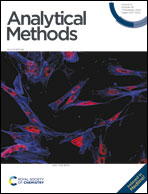An enzyme-free fluorescent biosensor for highly sensitive detection of carcinoembryonic antigen based on aptamer-induced entropy-driven circuit
Abstract
Carcinoembryonic antigen (CEA) is a disease biomarker, which can reflect the existence of tumors. The accurate detection of CEA in clinical samples is highly valuable for diagnosis of tumors. Herein, we developed an enzyme-free fluorescent biosensor for highly sensitive detection of CEA based on an aptamer-induced entropy-driven circuit. The aptamer hairpin specifically bound to CEA to expose the locked domain. Then, the exposed domain could trigger disassembly of multiple fluorophore strands from the three-strand complexes with the aid of fuel strands, leading to the production of remarkable amplified fluorescent signals. The one-step and homogeneous method exhibited high specificity and a wide linear range from 10 pg mL−1 to 500 ng mL−1 with a low limit of detection of 4.2 pg mL−1. What's more, the whole detection process could be performed within 45 min and did not involve the use of any protein enzymes and antibodies. The developed strategy could also be applied to detect CEA in clinical samples with satisfactory results. Therefore, the strategy is an alternative sensing method for the detection of CEA.



 Please wait while we load your content...
Please wait while we load your content...